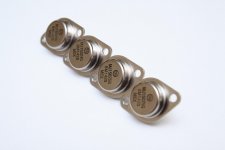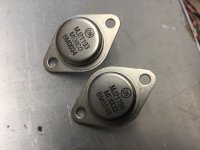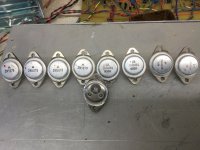# 90 Is the BM0504 marking the same for 15003 and 15004? Right? 🙁
yup....?
That is a valid making code from 2005, and the same # means they went through the assembly line (not necessarily the semiconductor process itself) at the same general timeframe. They probably ran assembly lots back to back to fill orders for both. Some big manufacturer probably ordered a bunch of both for a production run, possibly more than Mouser keeps on hand (and they may have negotiated price).
If in doubt measure the base-emitter capacitance. You’ll get around 4500 pF from this type made after 1990.
If in doubt measure the base-emitter capacitance. You’ll get around 4500 pF from this type made after 1990.
Just tried that...the MJ15003's are 2.96 and 3.11nf
....and MJ15004's are both 2.84nf...
what does that say?? 🙂
....and MJ15004's are both 2.84nf...
what does that say?? 🙂
That is a valid making code from 2005, and the same # means they went through the assembly line (not necessarily the semiconductor process itself) at the same general timeframe. They probably ran assembly lots back to back to fill orders for both. Some big manufacturer probably ordered a bunch of both for a production run, possibly more than Mouser keeps on hand (and they may have negotiated price).
If in doubt measure the base-emitter capacitance. You’ll get around 4500 pF from this type made after 1990.
I have some (what I believe to be) genuine Motorola MJ15003's and 4's with MEXICO under the type number and above the data code. Date code was '99. That was when ON semi was formed so I suspect that that MEXICO format stayed for a while. I've got some MJ2955's with the MEX code below the date code which is BM06...; so I'd guess your devices are genuine and the change to the coding was 2005-2006?
I have some (what I believe to be) genuine Motorola MJ15003's and 4's with MEXICO under the type number and above the data code. Date code was '99. That was when ON semi was formed so I suspect that that MEXICO format stayed for a while. I've got some MJ2955's with the MEX code below the date code which is BM06...; so I'd guess your devices are genuine and the change to the coding was 2005-2006?
So...not alone then 🙂, will hopefully do an objective test soon!
....Please take a look at the pics I've attached.
According to Rod Elliot's pages...these are counterfeit due to MEXICO at the bottom row...and not MEX...on 2nd row.
Also...date code not in correct place.
However...these were obtained from a 3rd party some 14/15 years ago as samples from ON-Semi, and I believe this info. to be reliable.
I've chatted with ON-Semi...and provided the picture below.
They suggest that printing standards/protocols may have changed over the years...and not to rely on the internet info.
They most certainly PASS the acetone test....but I haven't been able to test them conclusively yet.
Any thoughts out there please?
It's fake.
Genuine look like that.
Attachments
It's fake.
Genuine look like that.
....isn't that the whole point of this 'discussion'...?
The possibility (also 'echoed' by ON Semi)...that printing conventions alone cannot be relied on...?
These were obtained using the sample program, right after the “ON switch”. I got 50 of each, a big score as samples. I have used them all over the place - still have about a dozen each left. One batch of 20 each ended up in amplifiers running off +/-127 volts, and would drive *two* labhorns in parallel off each. I damn near melted the plugs off the extension cords at a gig once (it was LOUD with a lot of bass). I think they pass the authenticity test.
Attachments
Sometimes the real thing can be out of spec as well. I just had that happen to me!
Last edited:
The MJ15024G looks believable ... the the 15025 less so ... the 855A looks quite ridiculous ... the top and bottom of the can doesn't line up and there's sealant oozing out of it!
The Next row ... Left is believable ... the OPA may or may not ... the diode, don't believe ... it looks like it was made in a transistor mould ... and the C3423 ... altogether too sloppy looking
The Next row ... Left is believable ... the OPA may or may not ... the diode, don't believe ... it looks like it was made in a transistor mould ... and the C3423 ... altogether too sloppy looking
Sometimes the real thing can be out of spec as well. I just had that happen to me!
I had some surplus NOS TO-3’s that were out of spec. I bought about 100, and a dozen or so of them had single digit hFE. The majority were between 50 and 70, with a couple flyers running up over 300 for the PNP and 200 for the NPN (NPN is usually lower). They may have been rejects that ended up in somebody’s warehouse for*ever* and were eventually found. The klinkers got put in my ‘junk’ box. I did try (for s***s and giggles) to build an amplifier with a couple pairs of then, and the low gain parts oscillated uncontrollably. It was stable with more typical parts. One that had an hFE of 3 got sacrificed to see the innards. I did get enough good ones out of the bunch that they were still under a buck apiece.
Attachments
Hello Everyone.
I am late to this game. I am looking for 2 x 2SC2460B & 2 x 2SA1050B Toshiba's from 1978-82.
I would like to get O.E.M. a friend sent me a link today on eBay. They are from Shenzhen, in southeastern China and I am sure counterfeited. Has anyone solved this Toshiba transistor issue yet? I would like to get N.O.S. parts.
Steve.
I am late to this game. I am looking for 2 x 2SC2460B & 2 x 2SA1050B Toshiba's from 1978-82.
I would like to get O.E.M. a friend sent me a link today on eBay. They are from Shenzhen, in southeastern China and I am sure counterfeited. Has anyone solved this Toshiba transistor issue yet? I would like to get N.O.S. parts.
Steve.
I got 10 pcs 2SC4468 & 2SA1695 from Iscemi and change them in a broken amp (250W), they worked on the bench full load etc. But lasted 5min on a loudspeaker with signal !! I change them to real Sanken and now (until now) no problems !!! So Iscsemi might make a part that, on specs, looks like the real thing but will not last in "real" loads !! So beware
Ps. The datasheet also looks "funny" a cut and past from Sankens sheet !? 🤔
Ps. The datasheet also looks "funny" a cut and past from Sankens sheet !? 🤔
Sanken LAPT and Toshiba triple diffused parts FAR exceed their rated data sheet SOA. At least for short periods of time (long term reliability still wont be great). Manufacturers know this and take advantage. You often saw one pair of MT200’s on +/-70V. Do the math and see if you think it’s a good idea or not. Get something that just meets specs on paper and it won’t survive what manufacturers consider normal operation.
I would steer clear of anything which isn't sold by a licensed distributor. Digikey and Mouser are the only places i order power transistors from and if the part is obsolete, I'd first attempt to find a suitable cross reference and adapt it to the circuit ie. add stability caps, decoupling, etc.
I recently found a good replacement for the 2sa1302 2sc3281 from Mouser and they were very close to one another in HFE and junction capacitance from the same lot.
I recently found a good replacement for the 2sa1302 2sc3281 from Mouser and they were very close to one another in HFE and junction capacitance from the same lot.
- Home
- Amplifiers
- Solid State
- ### Counterfeit transistors


